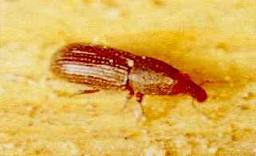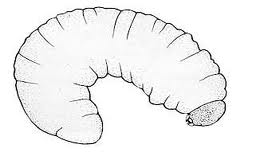The Weevil that Eats Wood
 The Wood Boring Weevil tends to attack wood which is already damp or decaying. For this reason, if you find an infestation of Wood Boring Weevils, however much damage they may have done themselves, you already have a problem with the wood. Sometimes they will attack wood adjacent to wood which is decaying, but in either case, there is some decaying wood close by which will need dealing with. The Wood Boring Weevil tends to attack wood which is already damp or decaying. For this reason, if you find an infestation of Wood Boring Weevils, however much damage they may have done themselves, you already have a problem with the wood. Sometimes they will attack wood adjacent to wood which is decaying, but in either case, there is some decaying wood close by which will need dealing with.
East Anglia and London suffers from the Wood Boring Weevil the most in the UK, but it strikes in other areas as well. Making sure that your timber is dry, not too humid and in good condition is the best defence against them. If you do find an infestation though then call in a pest controller to come and deal with the problem for you. They will also survey the rest of the area for other signs of damage by woodworm.
Woodworm is the name given to the larva of wood boring insects because it is in the larval stage that they do the vast majority of the damage to the wood. The Common Furniture Beetle is the most widespread type of woodworm in the UK, and they all have the basic lifecycle of egg to larva to pupa and finally adult beetle. The larval stage is almost always the longest, and the adult beetle usually only lasts a matter of days or weeks, because its only purpose is to mate and lay eggs. In fact, the Wood Boring Weevil does not follow this pattern exactly.
 In the case of the Wood Boring Weevil, the female lays the eggs in holes in the wood, and the eggs hatch in just over two weeks. Larva emerges from the egg and tunnels through the wood for a relatively short time for woodworm, six months or up to a year. It is in the shape of a “C” and grows to a maximum of 3mm. Next comes the pupal stage, which lasts for two or three weeks before the adult beetle is finally formed. It then bites up and out of the wood, forming the familiar woodworm holes. Unlike most woodworm, which leave either round or oval shaped holes, the wood boring weevil makes an irregular shaped exit hole. This is one of the only wood boring insects which actually does feed on wood beyond the larval stage, and so can live up to a year. In the case of the Wood Boring Weevil, the female lays the eggs in holes in the wood, and the eggs hatch in just over two weeks. Larva emerges from the egg and tunnels through the wood for a relatively short time for woodworm, six months or up to a year. It is in the shape of a “C” and grows to a maximum of 3mm. Next comes the pupal stage, which lasts for two or three weeks before the adult beetle is finally formed. It then bites up and out of the wood, forming the familiar woodworm holes. Unlike most woodworm, which leave either round or oval shaped holes, the wood boring weevil makes an irregular shaped exit hole. This is one of the only wood boring insects which actually does feed on wood beyond the larval stage, and so can live up to a year.
The Wood Boring Weevil is anything from two and a half to five millimetres long, and comes in colours from reddish sort of brown to black. They have short legs, a long nose and a body which is cylindrical shaped. They don’t fly but walk very fast.
There are a variety of different types of Wood Boring Weevil, and a good deal more types of wood boring insect. They all tend to like moist wood, so if the humidity is low then that is a good defence against all woodworm, but especially the Wood Boring Weevil. It can be hard to tell the difference between them from damage caused to an untrained eye, so even if you think it is one of the types of woodworm that does not need treatment it is always a good idea to get a professional opinion. If you have an infestation of Wood Boring Weevil then, as already mentioned, whatever the damage they have caused, the condition of the wood will already be bad so you should seek professional help as soon as possible.
|